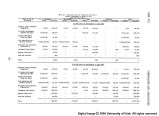| OCR Text |
Show PART III PRESENT STATUS OF DEVELOPMENT On dry cropland, hay and cropland pastures use 19 percent of the land; feed grains and wheat use 30 percent; and dry beans and miscellane- ous crops use 20 percent. Fallowed, temporarily idle, or conservation use accounts for 29 percent, and marginal land retired to grasses uses the re- maining 2 percent. Livestock grazing takes place on Qk percent of the land area. The 60.U million acres of range provide seasonal forage for the majority of the region's 850,000 cattle and calves and the 1,300,000 sheep and lairibs. Forage production was 6.3 million AUM! s in 1965, an AUM "being the forage required to feed one cow and one calf for 1 month. Grazing use depends upon the irrigated land "base for winter feed in this livestock-oriented region. Sheep are being moved from summer rangeland to home ranch for winter feeding. Of 27.k million acres of forest land, 9.h million acres are commer- cial timberland containing 56.8 billion cubic feet of sawtimber. ^In 3-9°5j 53.0 million cubic feet of timber were removed, about half of which, or 311 million board feet, was sawtimber. Of the timber harvested 98 percent was softwood. |













































































































































